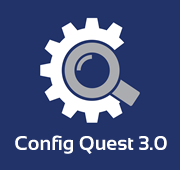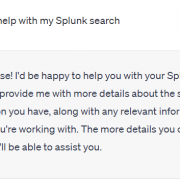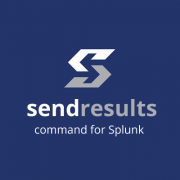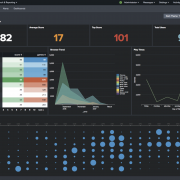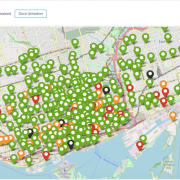Get Excited About The Splunk Cloud ACS CLI
Splunk Cloud Admins rejoice! The Splunk Cloud ACS Command Line Interface is here! Originally, the Splunk Cloud Admin Config Service (ACS) was released in January 2021 to provide various self-service features for Splunk Cloud Admins. It was released as an API-based service that can be used for configuring IP allow lists, configuring outbound ports, managing HEC tokens, and many more which are all detailed in the Splunk ACS Documentation.
To our excitement Splunk has recently released a CLI version of ACS. The ACS CLI is much easier to use and less error-prone compared to the complex curl commands or Postman setup one has had to deal with to-date. One big advantage we see with the ACS CLI is how it can be used in scripted approach or within a deployment CI/CD pipeline to handle application management and index management.
We would recommend that you first refer to the ACS Compatibility Matrix to understand what features are available to the Classic and Victoria experience Splunk Cloud platforms.
ACS CLI Setup Requirements
Before you get started with the ACS CLI there are a few requirements to be aware of:
- You must have the
sc_adminrole to be able to leverage the ACS CLI. - You must be running a Mac or Linux operating systems. However, if you are a Windows user you can use the Windows Subsystem for Linux (WSL), or any Linux VM running on Windows, to install and use the ACS CLI.
- The Splunk Cloud version you are interacting with must be above 8.2.2109 to use the ACS CLI. To use Application Management functions, your Splunk Cloud version must be 8.2.2112 or greater.
Please refer to the Splunk ACS CLI documentation for further information regarding the requirements and the setup process.
ACS CLI Logging
At the time of authoring this blog, logging and auditing of interactions through the Splunk Cloud ACS is not readily available to customers. However, when using the ACS CLI it will create a local log on the system where it is being used. It is recommended that any administrators given access to work with the ACS CLI have the log file listed below collected and forwarded to the their Splunk Cloud stack. This log file can be collected using the Splunk Universal Forwarder, or other mechanism, to create an audit trail of activities.
- Linux: $HOME/.acs/logs/acs.log
- Mac: $HOME/Library/Logs/acs/acs.log
The acs.log allows an administrator to understand what operations were run, request IDs, status codes and much more. We will keep an eye out for Splunk adding to the logging and auditing functionality not just in the ACS CLI but ACS as a whole and provide a future blog post on the topic when available.
Interacting With The ACS CLI
Below are examples of common interactions an administrator might have with Splunk Cloud now done by leveraging the Splunk Cloud ACS CLI. There are many more self-service features supported by the ACS CLI, details of the supported features and CLI operations are available in the Splunk Cloud ACS CLI documentation.
Application Management
One of the most exciting features of the ACS CLI is the ability to control all aspects of application management. That means, using the ACS CLI you can install both private applications and Splunkbase applications.
The command is easy to understand and straightforward, for both private and Splunkbase applications it supports commands to install, uninstall, describe applications within your environment as well as a list command to return a complete list of all installed applications, with their configurations. Specific to only Splunkbase applications there is an update command which allows you to, you guessed it, update the application to the latest version published and available.
For both private and Splunkbase apps, when running a command it will prompt you to enter your splunk.com credentials. You can pass –username –password parameters along with the command to avoid prompting for credentials. For private apps these credentials will be used to authenticate to AppInspect for application vetting.
Application Management: Installing a Private App
Let’s look at how we use the ACS CLI to install a private application. The following command will install a private app named company_test_app:
acs apps install private --acs-legal-ack Y --app-package /tmp/company_test_app.tgz |
Now when a private app is installed using the ACS CLI it will automatically be submitted to AppInspect for vetting. A successful execution of the command will result in the following response, which you will note includes the AppInspect summary:
Submitted app for inspection (requestId='*******-****-****-****-************')Waiting for inspection to finish... processing.. success Vetting completed, summary: {} Vetting successful Installing the app... {} |
Application Management: Installing a Splunkbase Application
Let’s now look at an example of installing a Splunkbase application by running a command to install the Config Quest application:
acs apps install splunkbase --splunkbase-id 3696 --acs-licensing-ack http://creativecommons.org/licenses/by/3.0/ |
The licensing URL passed as a parameter in the command above can be found in the application details on Splunkbase. Additionally, by running a curl command the licensing URL can be retrieved from the Splunkbase API:
curl -s --location --request GET 'https://splunkbase.splunk.com/api/v1/app/3696' --header 'Content-Type: text/plain' | jq .license_url |
Finally, a successful execution of the command will result in the following response:
Installing the app... { } |
Index Management
Index management using the ACS CLI supports a wide range of functionality. The supported commands allow you to create, update, delete and describe an index within your environment as well as a list command to return a list of all of the existing indexes, with their configurations.
Let’s now look at how we run one of these commands by running a command that creates a metrics index with 90 days searchable retention period. Note that ACS supports creating either event or metrics index, however it does not yet support configuring DDAA or DDSS.
acs indexes create --name scratch_01 --data-type metric --searchable-days 90 |
Finally, a successful execution of the command will return the following JSON response:
{ "searchableDays": 90, "maxDataSizeMB": 0, "totalEventCount": "0", "totalRawSizeMB": "0" |
HEC Token Management
Managing HTTP Event Collector (HEC) token’s just got real easy. The ACS CLI supports commands to create, update, delete and describe a HEC token within your environment as well as a list command to return a list of all of the existing HEC token’s, with their configurations.
Let’s now look at how we run one of these commands by running a command to create a HEC token in Splunk Cloud quickly and easily:
acs hec-token create --name test_token --default-index main --default-source-type test |
A successful execution of the command provides the token value in the JSON response:
{ |
© Discovered Intelligence Inc., 2022. Unauthorized use and/or duplication of this material without express and written permission from this site’s owner is strictly prohibited. Excerpts and links may be used, provided that full and clear credit is given to Discovered Intelligence, with appropriate and specific direction (i.e. a linked URL) to this original content.

